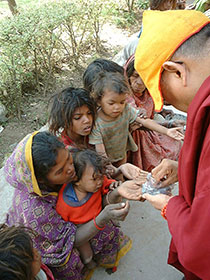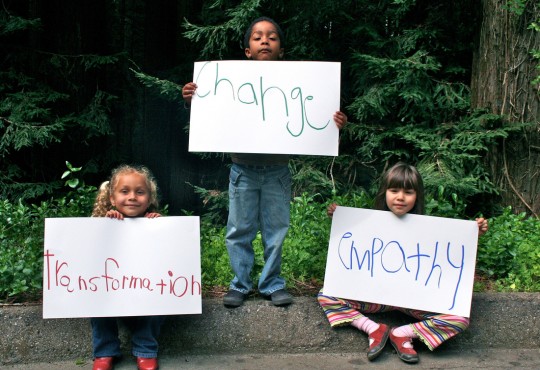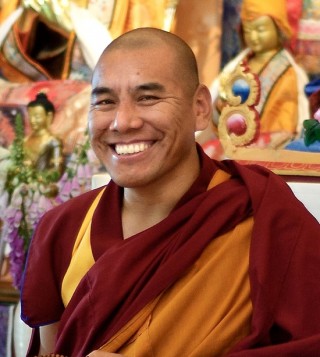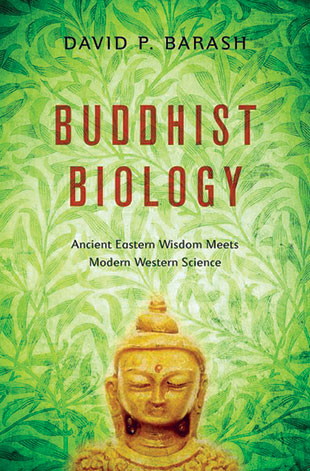- Home
- FPMT Homepage
Foundation for the Preservation of the Mahayana Tradition
The FPMT is an organization devoted to preserving and spreading Mahayana Buddhism worldwide by creating opportunities to listen, reflect, meditate, practice and actualize the unmistaken teachings of the Buddha and based on that experience spreading the Dharma to sentient beings. We provide integrated education through which people’s minds and hearts can be transformed into their highest potential for the benefit of others, inspired by an attitude of universal responsibility and service. We are committed to creating harmonious environments and helping all beings develop their full potential of infinite wisdom and compassion. Our organization is based on the Buddhist tradition of Lama Tsongkhapa of Tibet as taught to us by our founders Lama Thubten Yeshe and Lama Thubten Zopa Rinpoche.
- Willkommen
Die Stiftung zur Erhaltung der Mahayana Tradition (FPMT) ist eine Organisation, die sich weltweit für die Erhaltung und Verbreitung des Mahayana-Buddhismus einsetzt, indem sie Möglichkeiten schafft, den makellosen Lehren des Buddha zuzuhören, über sie zur reflektieren und zu meditieren und auf der Grundlage dieser Erfahrung das Dharma unter den Lebewesen zu verbreiten.
Wir bieten integrierte Schulungswege an, durch denen der Geist und das Herz der Menschen in ihr höchstes Potential verwandelt werden zum Wohl der anderen – inspiriert durch eine Haltung der universellen Verantwortung und dem Wunsch zu dienen. Wir haben uns verpflichtet, harmonische Umgebungen zu schaffen und allen Wesen zu helfen, ihr volles Potenzial unendlicher Weisheit und grenzenlosen Mitgefühls zu verwirklichen.
Unsere Organisation basiert auf der buddhistischen Tradition von Lama Tsongkhapa von Tibet, so wie sie uns von unseren Gründern Lama Thubten Yeshe und Lama Thubten Zopa Rinpoche gelehrt wird.
- Bienvenidos
La Fundación para la preservación de la tradición Mahayana (FPMT) es una organización que se dedica a preservar y difundir el budismo Mahayana en todo el mundo, creando oportunidades para escuchar, reflexionar, meditar, practicar y actualizar las enseñanzas inconfundibles de Buda y en base a esa experiencia difundir el Dharma a los seres.
Proporcionamos una educación integrada a través de la cual las mentes y los corazones de las personas se pueden transformar en su mayor potencial para el beneficio de los demás, inspirados por una actitud de responsabilidad y servicio universales. Estamos comprometidos a crear ambientes armoniosos y ayudar a todos los seres a desarrollar todo su potencial de infinita sabiduría y compasión.
Nuestra organización se basa en la tradición budista de Lama Tsongkhapa del Tíbet como nos lo enseñaron nuestros fundadores Lama Thubten Yeshe y Lama Zopa Rinpoche.
A continuación puede ver una lista de los centros y sus páginas web en su lengua preferida.
- Bienvenue
L’organisation de la FPMT a pour vocation la préservation et la diffusion du bouddhisme du mahayana dans le monde entier. Elle offre l’opportunité d’écouter, de réfléchir, de méditer, de pratiquer et de réaliser les enseignements excellents du Bouddha, pour ensuite transmettre le Dharma à tous les êtres. Nous proposons une formation intégrée grâce à laquelle le cœur et l’esprit de chacun peuvent accomplir leur potentiel le plus élevé pour le bien d’autrui, inspirés par le sens du service et une responsabilité universelle. Nous nous engageons à créer un environnement harmonieux et à aider tous les êtres à épanouir leur potentiel illimité de compassion et de sagesse. Notre organisation s’appuie sur la tradition guéloukpa de Lama Tsongkhapa du Tibet, telle qu’elle a été enseignée par nos fondateurs Lama Thoubtèn Yéshé et Lama Zopa Rinpoché.
Visitez le site de notre Editions Mahayana pour les traductions, conseils et nouvelles du Bureau international en français.
Voici une liste de centres et de leurs sites dans votre langue préférée
- Benvenuto
L’FPMT è un organizzazione il cui scopo è preservare e diffondere il Buddhismo Mahayana nel mondo, creando occasioni di ascolto, riflessione, meditazione e pratica dei perfetti insegnamenti del Buddha, al fine di attualizzare e diffondere il Dharma fra tutti gli esseri senzienti.
Offriamo un’educazione integrata, che può trasformare la mente e i cuori delle persone nel loro massimo potenziale, per il beneficio di tutti gli esseri, ispirati da un’attitudine di responsabilità universale e di servizio.
Il nostro obiettivo è quello di creare contesti armoniosi e aiutare tutti gli esseri a sviluppare in modo completo le proprie potenzialità di infinita saggezza e compassione.
La nostra organizzazione si basa sulla tradizione buddhista di Lama Tsongkhapa del Tibet, così come ci è stata insegnata dai nostri fondatori Lama Thubten Yeshe e Lama Zopa Rinpoche.
Di seguito potete trovare un elenco dei centri e dei loro siti nella lingua da voi prescelta.
- 欢迎 / 歡迎
简体中文
“护持大乘法脉基金会”( 英文简称:FPMT。全名:Foundation for the Preservation of the Mahayana Tradition) 是一个致力于护持和弘扬大乘佛法的国际佛教组织。我们提供听闻,思维,禅修,修行和实证佛陀无误教法的机会,以便让一切众生都能够享受佛法的指引和滋润。
我们全力创造和谐融洽的环境, 为人们提供解行并重的完整佛法教育,以便启发内在的环宇悲心及责任心,并开发内心所蕴藏的巨大潜能 — 无限的智慧与悲心 — 以便利益和服务一切有情。
FPMT的创办人是图腾耶喜喇嘛和喇嘛梭巴仁波切。我们所修习的是由两位上师所教导的,西藏喀巴大师的佛法传承。
繁體中文
護持大乘法脈基金會”( 英文簡稱:FPMT。全名:Found
ation for the Preservation of the Mahayana Tradition ) 是一個致力於護持和弘揚大乘佛法的國際佛教組織。我們提供聽聞, 思維,禪修,修行和實證佛陀無誤教法的機會,以便讓一切眾生都能 夠享受佛法的指引和滋潤。 我們全力創造和諧融洽的環境,
為人們提供解行並重的完整佛法教育,以便啟發內在的環宇悲心及責 任心,並開發內心所蘊藏的巨大潛能 — 無限的智慧與悲心 – – 以便利益和服務一切有情。 FPMT的創辦人是圖騰耶喜喇嘛和喇嘛梭巴仁波切。
我們所修習的是由兩位上師所教導的,西藏喀巴大師的佛法傳承。 察看道场信息:
- FPMT Homepage
- News/Media
-
- Study & Practice
-
-
- About FPMT Education Services
- Latest News
- Programs
- New to Buddhism?
- Buddhist Mind Science: Activating Your Potential
- Heart Advice for Death and Dying
- Discovering Buddhism
- Living in the Path
- Exploring Buddhism
- FPMT Basic Program
- FPMT Masters Program
- FPMT In-Depth Meditation Training
- Maitripa College
- Lotsawa Rinchen Zangpo Translator Program
- Universal Education for Compassion & Wisdom
- Online Learning Center
-
- Prayers & Practice Materials
- Overview of Prayers & Practices
- Full Catalogue of Prayers & Practice Materials
- Explore Popular Topics
- Benefiting Animals
- Chenrezig Resources
- Death & Dying Resources
- Lama Chopa (Guru Puja)
- Lama Zopa Rinpoche: Compendium of Precious Instructions
- Lama Zopa Rinpoche: Life Practice Advice
- Lama Zopa Rinpoche Practice Series
- Lamrim Resources
- Mantras
- Prayer Book Updates
- Purification Practices
- Sutras
- Thought Transformation (Lojong)
- Audio Materials
- Dharma Dates - Tibetan Calendar
- Translation Services
- Publishing Services
- Ways to Offer Support
- Prayers & Practice Materials
-
- Teachings and Advice
- Find Teachings and Advice
- Lama Zopa Rinpoche Advice Page
- Lama Zopa Rinpoche: Compendium of Precious Instructions
- Lama Zopa Rinpoche Video Teachings
- ༧སྐྱབས་རྗེ་བཟོད་པ་རིན་པོ་ཆེ་མཆོག་ནས་སྩལ་བའི་བཀའ་སློབ་བརྙན་འཕྲིན།
- Podcasts
- Lama Yeshe Wisdom Archive
- Buddhism FAQ
- Dharma for Young People
- Resources on Holy Objects
- Teachings and Advice
-
-
*If a menu item has a submenu clicking once will expand the menu clicking twice will open the page.
-
-
- Centers
-
- Teachers
-
- Projects
-
-
-
-
*If a menu item has a submenu clicking once will expand the menu clicking twice will open the page.
-
-
- FPMT
-
-
-
-
-
We are not compelled to meditate by some outside agent, by other people, or by God. Rather, just as we are responsible for our own suffering, so are we solely responsible for our own cure. We have created the situation in which we find ourselves, and it is up to us to create the circumstances for our release. Therefore, as suffering permeates our life, we have to do something in addition to our regular daily routine. This “something” is spiritual practice or, in other words, meditation.
The Purpose of Meditation
Lama Yeshe Wisdom ArchiveLama Zopa Rinpoche
-
-
-
- Shop
-
-
-
The Foundation Store is FPMT’s online shop and features a vast selection of Buddhist study and practice materials written or recommended by our lineage gurus. These items include homestudy programs, prayers and practices in PDF or eBook format, materials for children, and other resources to support practitioners.
Items displayed in the shop are made available for Dharma practice and educational purposes, and never for the purpose of profiting from their sale. Please read FPMT Foundation Store Policy Regarding Dharma Items for more information.
-
-
Mandala
Pam Cayton, founder of Tara Redwood School, a pre-school and elementary program near Santa Cruz, California, that “strives to develop the whole child: mental, physical and spiritual,” and Creating Compassionate Cultures (CCC), an organization dedicated to providing tools and training to help educators offer children a deeper, holistic education, shared this news with Mandala:
On Saturday March 22, Tara Redwood School held their annual fundraising auction. Each classroom creates a group art piece to raise money for the scholarship program and the school development fund.
This clock was created by the children in the kindergarten and first grade class. The teacher asked them what message they thought would be helpful for people to live a happy life. This was generated from their discussions and voted on as the message they all wanted to send. Each child drew their self-portrait and their artwork was placed under clear glass jewels, set into a circle around the clock face. This represented the potential we all have to bring those jewel-like qualities into every moment, affecting ourselves, our friends, family and communities, thus making this world a happier, more peaceful planet and home for all! The classroom projects are always the most popular items for parents to bid on and this is a wonderful example of one of them.
The classroom projects are also a great representation of the Creating Compassionate Cultures organization and curriculum, which officially launched their Online Institute for Creating Compassionate Cultures (OICCC) on March 31. The Online Institute offers a 12-course online certification course to educators and anyone interested in learning the CCC curriculum and its methodology – the Seven Steps to Knowledge, Strength and Compassion, the theoretical basis that helps the curriculum develop a child’s natural ethics, wisdom and compassion.
Creating Compassionate Cultures invites parents, teachers, psychologists, counselors and coaches to explore the Online Institute for Creating Compassionate Cultures (OICCC).
Mandala brings you news of Lama Zopa Rinpoche and of activities, teachings and events from over 160 FPMT centers, projects and services around the globe. If you like what you read on Mandala, consider becoming a Friend of FPMT, which supports our work.
Chandrakirti Tibetan Buddhist Meditation Centre is situated in the rolling hills of Nelson, New Zealand, on the northern end of the country’s South Island.
In the online edition of Mandala April-June 2014, we share a video by Peter Kemp of the center’s beautiful grounds and featuring the center’s resident geshe, Geshe Jampa Tharchin.
Mandala brings you news of Lama Zopa Rinpoche and of activities, teachings and events from over 160 FPMT centers, projects and services around the globe. If you like what you read on Mandala, consider becoming a Friend of FPMT, which supports our work.
28
Book Review: ‘Buddhist Biology’
Buddhist Biology: Ancient Eastern Wisdom Meets Modern Western Science
By David P. Barash; Reviewed by Jacob Sky Lindsley
Some curious students of contemporary Buddhism will be familiar with the ongoing dialogue between Buddhism and science. Events like the “Mind and Life” conferences put high-profile scientists in selfies with the Dalai Lama and other well-known Buddhists. While psychology, neurology, and physics have tended to be the disciplines most featured in such prestigious conferences, Dr. Barash’s Buddhist Biology attempts to add biology to this interesting discussion. Though many of the questions he asks are undeniably fascinating and profound, his overall approach seems ill suited to the task.
Before we go into a critique, Barash should be given credit where it is due. He is a buoyant, colorful and playful writer and doesn’t flinch when tackling complex questions. Additionally, his vocal call for human beings to take responsibility for their effect on the planet reveals his overwhelmingly positive motivation. He sees in Buddhism the potential to ground the insights of biology in a way that highlights human moral imperatives. He does a good job of highlighting the sheer wonder of our world and the reader can really feel how much he loves our Earth.
But as a rule, Barash does not entertain discussion on anything that falls outside the boundaries of his worldview. His downright ornery insistence on what he calls the “natural, the real, the material” makes it difficult for him to appreciate the methodology of the Buddhist tradition. While certainly understandable given his training, it nevertheless clouds his discernment and weakens his conclusions.
The book is roughly divided into two exercises: a discussion centered on the ways Barash sees Buddhist philosophy through the lens of contemporary biology, and, a moral argument for acting urgently on climate change. In his discussion of Buddhist philosophy, he comes across as mocking and dismissive of whatever parts of the tradition that do not conform to the philosophy of science. He uses the controversial work of Stephen Batchelor as the main justification for his method, interspersed with cherry-picked quotes from other popular Buddhist figures and Buddhist literature. I imagine that many of these authors would take issue with Barash’s approach – and he suspects as much, admitting that even Stephen Batchelor wouldn’t likely go as far as he does on some issues. It seems that for Barash, the story of biology and his vision of science necessarily have every answer, which makes his book a soliloquy rather than a true dialogue.
Barash’s main issue seems to be that he has difficulty seeing Buddhism as itself, switching between what José Cabezón calls the “identity” and “conflict” models of scientific engagement with Buddhism. In the first model, scientific concepts are “identical” with Buddhist ones, or vice versa. For example, early on Barash regards “Buddha Nature” as a teaching about “biological continuity among all living things” through time. While there is a possibly interesting convergence between the two, there is a highly significant gap between them that he leaves unexplored. In the second model, the two traditions are seen as inherently incompatible or even in “conflict.” We need only refer to the sections where he takes an insulting tone, using terms like “hocus-pocus” and “poppycock,” to refer to scriptural Buddhist ideas such as the knowledge of previous lives.
For a real dialogue to occur, one must be open to putting differences, as well as convergences, into conversation. This third, more responsible approach is what Cabezón calls the “complementarity” model. Complementarity acknowledges that each view (scientific and Buddhist) has something unique to contribute to the pursuit of knowledge. They may have different objects or different methods, but each contributes equally to a valid view of a more holistic reality. Barash doesn’t seem aware of the possibility that Buddhism might have some interesting criticism of his own assumptions. Instead, he seems to instinctively dismiss the strange or unknown as garbage in the name of Buddhist Modernism. This could be because he has not taken the time to thoroughly understand these areas of difference.
At times, Barash seems to have a confused – if not frustratingly wrong – understanding of some Buddhist concepts. For example, in one of the more interesting parts of the book, he asks how the theories of evolution and karma might inform each other. However, rather than examine the merits or weaknesses in the ideas of karma and reincarnation, he simply reduces what can be said about it to the “recycling of atoms and molecules” and proceeds to lament the fact that Buddhism insists on a “soul.” The Buddhist notion of reincarnation is not an easy subject, but to frame karma through the “mind/body” duality of Renaissance Europe is simply a mischaracterization. It doesn’t take much research to know that atman – as the soul and primordial self – was one of the main targets of Buddha’s critique of his Vedic contemporaries. A nuanced appreciation of this point should be basic to any discussion of karma or rebirth. There are too many places in the book where he makes blunders like this, undermining his credibility.
In addition, his monistic materialist reduction makes it difficult for him to rally the reader to his main point. When he attempts to move the discussion to ethical implications, the portrait of a world where free will is impossible and our genes rule behavior fails to inspire. We humans, understood as lumbering biological robots bent on self-preservation, can only encounter his pleas as one more thing to be consumed on our road to procreation and meaningless death. I really wanted Barash to succeed here, but the impersonal limitations of his appeal made it feel stale. One has to wonder whether it really matters if the world destroys itself. What makes one configuration of molecules better than another one?
Barash’s Buddhist Biology is a book about biology, but it has little to do with Buddhism. A more accurate title would be: What Biological Ideas Buddhism Has Too. There is certainly a lot of good information and interesting questions in his work, but readers looking for a conversation between Buddhism and science would do well to find books that engage these questions more maturely and with less speculation, such as the many that have been based on the Mind and Life dialogues. A good start might be Varela and Hayward’s Gentle Bridges. Barash is certainly less than gentle in his treatment of this complex and delicate topic, and his “bridge” looks more like a fortress. For Barash or any author wanting to have a place in these nascent explorations of the intersection of the Buddha and the boson, he or she will need to raise the portcullis and open the gate a bit more.
Published by Oxford University Press
Hardcover US$29.95
http://global.oup.com
- Tagged: book review, mandala, science
- 0
28
Establishing a Daily Practice
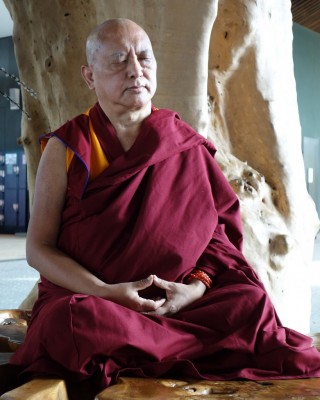
Lama Zopa Rinpoche meditating under a tree in gardens in Singapore, March 2013. Photo by Ven. Roger Kunsang.
In October 2013 FPMT Education Services released Daily Meditation by Lama Zopa Rinpoche, which is a collection of the prayers, practices and meditations needed to start one’s day with a perfect Dharma intention and bodhichitta motivation. Rinpoche has also been recently commenting on the need for FPMT students to actualize the lam-rim teachings and achieve realizations. Rinpoche has given extensive advice on orienting one’s daily practice with these aims.
Establishing a consistent daily Buddhist practice, or routine, is essential for ensuring consistent progress along the path. FPMT Education Services has put together a list of resources available on fpmt.org, the Lama Yeshe Wisdom Archive and the FPMT Foundation Store to those interested in initiating or strengthening a daily practice. …
From Mandala April-June 2014
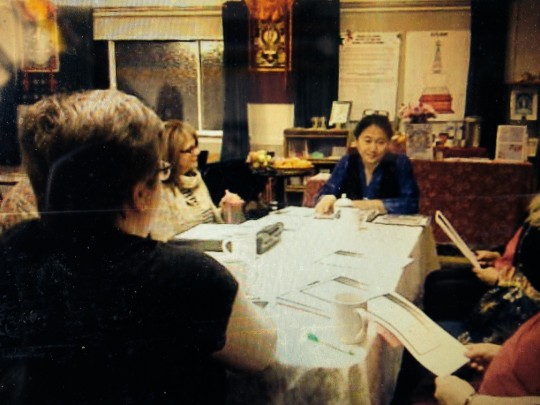
Dr. Yangdron Kalzang leading women’s health workshop, March 7, 2014. Photo courtesy of Tibetan Wellness & Healing Center.
On March 7, The Tibetan Wellness & Healing Center in Daly City, California and FPMT center Tse Chen Ling in San Francisco, organized and hosted the second annual workshop with Menpa (Doctor) Yangdron Kalzang on Tibetan medicine for women. In celebration of International Women’s Day, Dr. Kalzang taught self-care techniques – including hormey, a hot oil poultice – and discussed health topics such as thyroid problems, hormonal imbalances, menstruation, menopause as well as modern day stress and mental health.
Dr. Kalzang focused on the relationship between stress and hormonal imbalances and what therapies can be helpful besides taking hormonal replacement. According to Tibetan medicine, the symptoms of menopause – including hot flashes, osteoporosis, night sweats, PMS and dry eyes, throat, mouth, and skin – are connected with the imbalance of the “five elements.”
Dr. Kalzang demonstrated the use of hormey, which she promotes as a simple, cost-effective method to alleviate stress, improve sleep or insomnia, calm over-thinking, promote relaxation and boost the immune system. Used for thousands of years in Tibet, Tibetan grandmothers have been using this poultice for so long that it is called “grandmothers’ remedy,” Dr. Kalzang explained. Ingredients include nutmeg and caraway seed, and oil – either ghee or sesame oil – applied to “11 common points,” which she demonstrated during the workshop.
“One member of the group had been having some neck pain and was happy to let Dr. Kalzang work on her,” said Lisa Nystrom, center director of Tse Chen Ling. “Dr. Kalzang applied the poultice, which did wonders for our member. Her pain was relieved almost immediately! She said her neck hadn’t felt that good in a long time. Dr. Kalzang is an esteemed member of the Tse Chen Ling community and we look forward to continuing to host her talks and workshops in the future.”
At the workshop’s end, all participants went out for dinner and the student celebrated her relief from pain by treating the group!
Mandala brings you news of Lama Zopa Rinpoche and of activities, teachings and events from over 160 FPMT centers, projects and services around the globe. If you like what you read on Mandala, consider becoming a Friend of FPMT, which supports our work.
- Tagged: mandala, medicine, tse chen ling, women
- 0
26
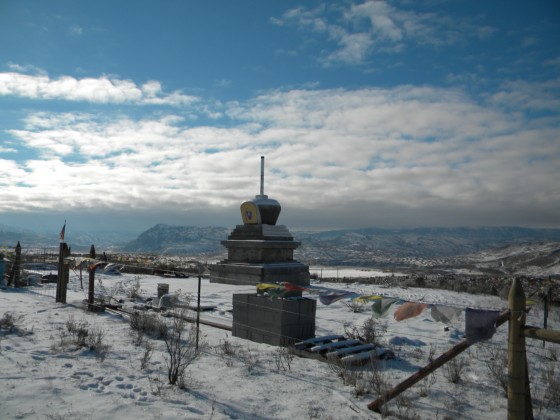
Pamtingpa Center’s nearly complete stupa, Tonasket, Washington, US, January 2014. Photo by Su Ianniello.
Su Ianniello, spiritual program coordinator at Pamtingpa Center, a small FPMT center in north central Washington in the United States, shares in the April-June 2014 issue of Mandala the story of how the students there came together to fulfill Lama Zopa Rinpoche’s advice to build a stupa.
“A few years ago, Lama Zopa Rinpoche came to the land. As we were all leaving, Rinpoche turned and looked out over the mountains and said, ‘A stupa here.’ That’s how our stupa building project began,” Su writes. “We were still trying to figure out how complete the project two years later. When Lama Zopa Rinpoche came back to town, he told us to build the gompa first, giving us some funds to begin this new project. However, a few weeks after Rinpoche left, we got a message to go back to the stupa project, using the funds for the gompa. These were some good lessons in flexibility.”
Read the complete story with our online edition for Mandala April-June 2014.
Mandala brings you news of Lama Zopa Rinpoche and of activities, teachings and events from over 160 FPMT centers, projects and services around the globe. If you like what you read on Mandala, consider becoming a Friend of FPMT, which supports our work.
- Tagged: mandala, stupa fund
- 0
26
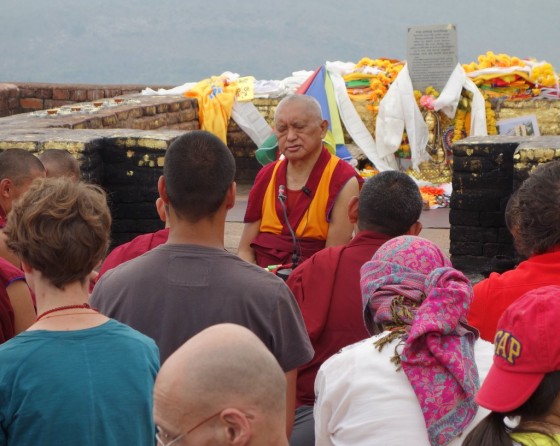
Lama Zopa Rinpoche giving an oral transmission of the Vajra Cutter Sutra on Vulture’s Peak, India, March 2014. Photo by Ven. Roger Kunsang.
“The Vajra Cutter Sutra is unbelievable. It is one of the most profitable practices because the root of all sufferings, yours and others, is the ignorance holding ‘I’ as truly existent, even though it is empty of that; and the ignorance holding the aggregates as truly existent, even though they are empty of that. The only antidote to cut that, to get rid of that and through which to achieve liberation, the total cessation of the suffering causes – delusions and karma – is the wisdom realizing emptiness. This is the subject of the Vajra Cutter Sutra, emptiness. So, each time you read it, it leaves such a positive imprint. Without taking much time, without much difficulty, it is easy to actualize wisdom. …”
– Lama Zopa Rinpoche, from “The Benefits of Reciting the Vajra Cutter Sutra”
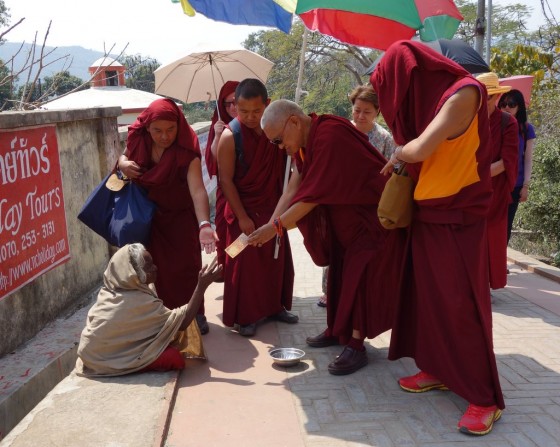
Lama Zopa Rinpoche visiting Rajgir and offering to the beggars on the way up to Vulture’s Peak, India, March 2014. Photo by Ven. Roger Kunsang.
Learn more about Lama Zopa Rinpoche, spiritual director of the Foundation for the Preservation of Mahayana Tradition (FPMT), and Rinpoche’s vision for a better world. Sign up to receive news and updates.
- Tagged: lama zopa rinpoche, mandala, vajra cutter sutra
- 0
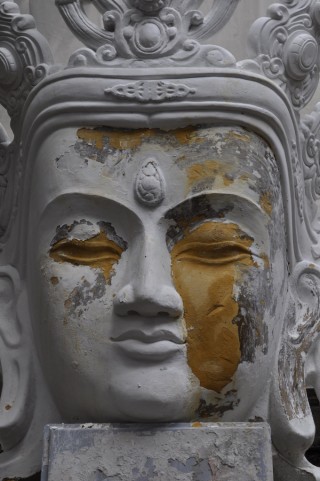
The bust of the Kundun Chenrezig, which is currently being repaired at Istituto Lama Tzong Khapa, Italy, 2012. Photo courtesy of Istituto Lama Tzong Khapa.
Francesca Sala, a student at Istituto Lama Tzong Khapa in Italy, shares in the April-June 2014 issue of Mandala the center’s new project to restore the large Chenrezig statue used in the 1997 Martin Scorsese film Kundun, about the life of His Holiness the 14th Dalai Lama.
She writes, “By 2012, the statue had made its way to Istituto Lama Tzong Khapa in Pomaia, Italy, and was displayed in the main square to awestruck residents. The giant sculpture, almost eight meters (26 feet) high, had lost some of its initial splendor as its last months in the Atlas Studio in Morocco had damaged its brittle polystyrene body. However, the extraordinary potential of the statue was clear from the beginning. …”
Read the complete article with Mandala’s online edition for our April-June 2014 issue.
Mandala brings you news of Lama Zopa Rinpoche and of activities, teachings and events from over 160 FPMT centers, projects and services around the globe. If you like what you read on Mandala, consider becoming a Friend of FPMT, which supports our work.
21
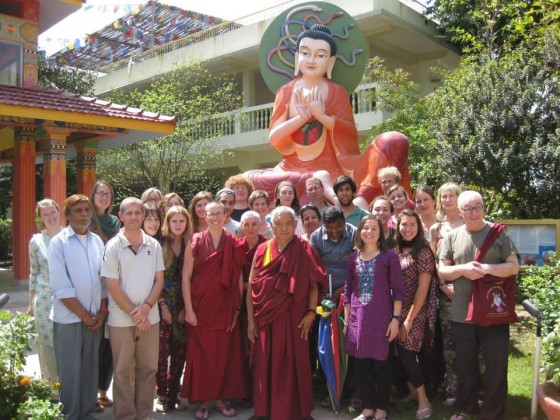
Lama Zopa Rinpoche with the students and staff of Experience Buddhism at the Root, Root Institute, Bodhgaya, India, March 2014. Photo courtesy of Ven. Lozang Khadro.
Ven. Lozang Khadro, spiritual program coordinator at Root Institute in Bodhgaya, India, shares news from the center’s annual “Experience Buddhism at the Root” event, a combination pilgrimage and lam-rim course, which ended March 14:
Our annual course “Experience Buddhism at the Root” took its experiential component to the maximum this March!
The students who attended ranged from 19 to 55 in “wisdom years” and they all came together to follow in the footsteps of the Buddha during the 10-day exploratory course. Ven. Sarah Thresher was our teacher and enthusiastic pilgrimage leader with Andy Melnic as our experienced meditation leader. Teachings and meditations at the holy sites of the Mahabodhi Stupa, Mahakala Caves, Vulture’s Peak and Nalanda University allowed Buddhism to come to life.
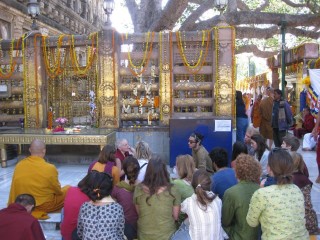
Under the shade of the Bodhi tree, Ven. Sarah Thresher shared the story of the Buddha’s path to enlightenment, Mahabodhi Stupa, Bodhgaya, India, March 2014. Photo courtesy of Ven. Lozang Khadro.
The group had incredible karma, meeting His Holiness the Sakya Trinzin after their pilgrimage to the Mahakala Caves. Lama Zopa Rinpoche was also in residence at Root Institute and offered much of his precious time to the group, leading an extensive Guru Puja, giving sutra transmissions at the Mahabodhi Stupa in Bodhgaya and Vulture’s Peak at Rajgir, as well as spontaneous Dharma talks. At the conclusion of the course each student was given a blessed mala and picture of the Mahabodhi Buddha statue by Lama Zopa Rinpoche.
Our annual “Experience Buddhism at the Root” course aims to take advantage of the amazing holy sites in and around Bodhgaya. Being able to hear teachings at the site of the Buddha’s enlightenment, contemplate beside the cave of Shariputra and meditate near the Mahakala Caves provides a uniquely rich and realistic context to the teachings, allowing each person to become personally engaged. Students described it as a meaningful experience which made the teachings very accessible.
Thank you to everyone who contributed. Students, staff and volunteers all made it a course to remember! We also wish to send a heartfelt thank you to Lama Zopa Rinpoche for his great kindness throughout the course.
Root Institute for Wisdom Culture is a socially engaged center providing a special environment for study, practice and retreat and is just a short walk from the Mahabodhi Stupa, where the Buddha attained enlightenment, and many other holy Buddhist pilgrimage sites.
Mandala brings you news of Lama Zopa Rinpoche and of activities, teachings and events from over 160 FPMT centers, projects and services around the globe. If you like what you read on Mandala, consider becoming a Friend of FPMT, which supports our work.
- Tagged: mandala, pilgrimage, root institute
- 0
20
Andy Wistreich, FPMT registered teacher and coordinator of Land of Joy, a developing FPMT retreat center in the UK, sent this exciting update on the group’s ongoing property hunt:
“Following extensive research, property visits all over the UK and a long check by Lama Zopa Rinpoche, Rinpoche advised us to progress the purchase of Greenhaugh Hall in Northumbria as quickly as possible.
“Greenhaugh Hall is attracting a lot of attention as its setting and views are simply beautiful – perfect for the type of retreat center we have been looking for, but also a perfect location for other purchasers. The pressure is on to raise enough funds right now, in order for us to begin negotiations with the vendor before someone else makes a better offer.”
Land of Joy hopes to raise £350,000 (US$581,875) by September 2014 in order to make an appropriate offer. Find more information about their progress and ways to participate on their homepage and Facebook page.
Mandala brings you news of Lama Zopa Rinpoche and of activities, teachings and events from over 160 FPMT centers, projects and services around the globe. If you like what you read on Mandala, consider becoming a Friend of FPMT, which supports our work.
- Tagged: land of joy, mandala
- 0
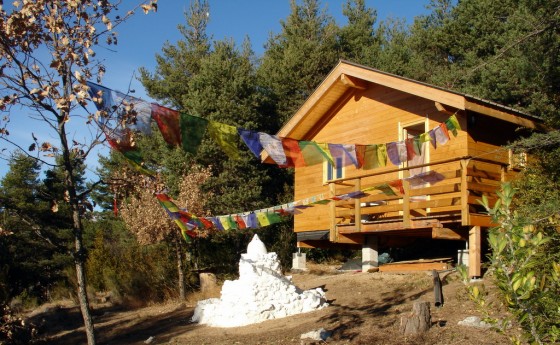
Dechen Ling, the first meditation chalet at Thakpa Kachoe Retreat Land, Villatale, France. Photo courtesy of Thakpa Kachoe Retreat Land.
Sylvaine Litaud, co-director of Thakpa Kachoe Retreat Land, shares exciting news about the FPMT retreat facility and aromatic and medicinal plant farm located in the mountainous southeastern corner of France:
The first meditation chalet at Thakpa Kachoe Retreat Land, called “Dechen Ling” was completed last summer and hosted its first solitary retreat. It was quite a rush to have it ready for Ven. Charles, who had planned six months before to start a retreat at the end of August 2013. At that time, there was not even a sign of a single euro for the work left to be done – 300 meters (984 feet) of a heavy electric wire had to be unfolded and tracked through the sloping forest.
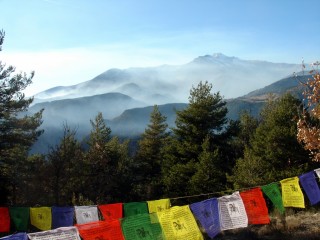
The vista from Thakpa Kachoe Retreat Land’s first meditation chalet. Photo courtesy of Thakpa Kachoe Retreat Land.
However, it is really amazing to see how things can work out quickly when the positive energy of such senior meditators is involved, and now, a small nice wooden house in the middle of wild nature with all amenities and facing a beautiful landscape is ready to host modern yogis and yoginis.
Ven. Charles presence could not have been a better inauguration for Thakpa Kachoe and all sponsors and volunteers were very happy. We thank all our Dharma friends who helped the building financially, including the International Merit Box Project donors.
Mandala brings you news of Lama Zopa Rinpoche and of activities, teachings and events from over 160 FPMT centers, projects and services around the globe. If you like what you read on Mandala, consider becoming a Friend of FPMT, which supports our work.
- Tagged: mandala, thakpa kachoe retreat land
- 0
17
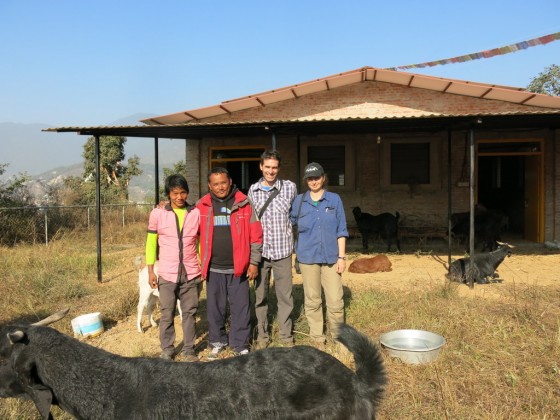
Umbar, the new caretaker, manager Pema, Phil Hunt and Tania Duratovic, Nepal, January 2014. Photo courtesy of Animal Liberation Sanctuary.
Phil Hunt, co-coordinator of Enlightenment for the Dear Animals, shares the most recent updates from Animal Liberation Sanctuary (ALS), a sanctuary for animals rescued by Lama Zopa Rinpoche from being killed or neglected so that they may live out their natural lives in peace and attain a higher rebirth:
At the start of November 2013, Dr. Howard Ralph from Australia was called over to undertake several operations on the animals assisted by ALS coordinator Tania Duratovic. Goats Norbu, Nyingjey, Tilopa, Tsering, Khedrup, Dawa (a sheep), and others benefited from this visit. Several Nepali veterinarians came to observe the operations as it is a rare thing for them to be able to participate in surgery.
The animals also benefited from Kopan’s annual November course. Students recited mantras and prayers every morning to the animals and many helped out during the mad rush of 34 animals circumambulating (running) around the stupa, keeping them from escaping to the garden.
The new year began with the four-legged residents of the Animal Liberation Sanctuary at Kopan Monastery and Kopan Nunnery in Nepal moving to their new living quarters on land nearby. The land was originally purchased in 2006 but building work did not begin until 2011. A young caretaker family has moved in and in the first week of January so did the animals: 48 goats and 2 sheep (8 cows will remain at Kopan where the terrain is more suitable for them). The move took place over a couple of days with animals being led (or often the other way around!) by several workers from Kopan. The track is very steep and narrow in places so we were quite anxious that the more compromised animals, like Dawa the three-legged sheep and Norbu with his partially amputated leg, may not make it. But they all arrived safely, although very exhausted, and set straight in munching on the grass and leaves.
The monastery residents and the nunnery residents hadn’t met each other so that was another concern for us, but they all seemed to get on quite well, even with a few head butts and a bit of pushing. The new shelter has facilities to separate quieter animals, including a separate stall for Dawa and Nyima the two sheep to sleep safely, as well as a quarantine area and a treatment room. We were also happy to have Roshan from MEND pay us a visit to measure Norbu for a prosthetic limb. We are all very happy that the move went well and the animals are all settling into their new premises. We look forward to them all having a long and healthy peaceful life there.
Learn more about Enlightenment for the Dear Animals and the Animal Liberation Sanctuary Project on their website. You can support the project by visiting their information page on fpmt.org.
Mandala brings you news of Lama Zopa Rinpoche and of activities, teachings and events from over 160 FPMT centers, projects and services around the globe. If you like what you read on Mandala, consider becoming a Friend of FPMT, which supports our work.
- Home
- News/Media
- Study & Practice
- About FPMT Education Services
- Latest News
- Programs
- New to Buddhism?
- Buddhist Mind Science: Activating Your Potential
- Heart Advice for Death and Dying
- Discovering Buddhism
- Living in the Path
- Exploring Buddhism
- FPMT Basic Program
- FPMT Masters Program
- FPMT In-Depth Meditation Training
- Maitripa College
- Lotsawa Rinchen Zangpo Translator Program
- Universal Education for Compassion & Wisdom
- Online Learning Center
- Prayers & Practice Materials
- Overview of Prayers & Practices
- Full Catalogue of Prayers & Practice Materials
- Explore Popular Topics
- Benefiting Animals
- Chenrezig Resources
- Death & Dying Resources
- Lama Chopa (Guru Puja)
- Lama Zopa Rinpoche: Compendium of Precious Instructions
- Lama Zopa Rinpoche: Life Practice Advice
- Lama Zopa Rinpoche Practice Series
- Lamrim Resources
- Mantras
- Prayer Book Updates
- Purification Practices
- Sutras
- Thought Transformation (Lojong)
- Audio Materials
- Dharma Dates – Tibetan Calendar
- Translation Services
- Publishing Services
- Teachings and Advice
- Find Teachings and Advice
- Lama Zopa Rinpoche Advice Page
- Lama Zopa Rinpoche: Compendium of Precious Instructions
- Lama Zopa Rinpoche Video Teachings
- ༧སྐྱབས་རྗེ་བཟོད་པ་རིན་པོ་ཆེ་མཆོག་ནས་སྩལ་བའི་བཀའ་སློབ་བརྙན་འཕྲིན།
- Podcasts
- Lama Yeshe Wisdom Archive
- Buddhism FAQ
- Dharma for Young People
- Resources on Holy Objects
- Ways to Offer Support
- Centers
- Affiliates Area
- Teachers
- Projects
- Charitable Projects
- Make a Donation
- Applying for Grants
- News about Projects
- Other Projects within FPMT
- Support International Office
- Projects Photo Galleries
- Give Where Most Needed
- FPMT
- Shop
Subscribe to FPMT News
Translate*
*powered by Google TranslateTranslation of pages on fpmt.org is performed by Google Translate, a third party service which FPMT has no control over. The service provides automated computer translations that are only an approximation of the websites' original content. The translations should not be considered exact and only used as a rough guide.Letting go of attachment brings inner satisfaction and peace.







